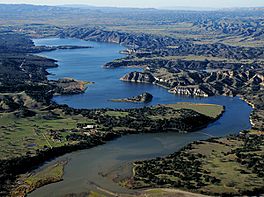Lake Cachuma facts for kids
Quick facts for kids Cachuma Lake |
|
|---|---|
 |
|
| Location | Los Padres National Forest Santa Barbara County, California |
| Coordinates | 34°35′12″N 119°58′52″W / 34.5866555°N 119.9809753°W |
| Type | Reservoir |
| Primary inflows | California Aqueduct Santa Ynez River |
| Primary outflows | Santa Ynez River |
| Basin countries | United States |
| Surface area | 3,100 acres (1,300 ha) |
| Water volume | 205,000 acre⋅ft (253,000,000 m3) |
| Surface elevation | 753 ft (230 m) |
Cachuma Lake is a large reservoir (an artificial lake) located in the Santa Ynez Valley in Santa Barbara County, California. It was created on the Santa Ynez River in 1953.
This lake was formed when the U.S. Bureau of Reclamation built the Bradbury Dam. The dam is a big structure made of earth, about 201 ft (61 m) tall.
Cachuma Lake covers an area of about 3,100 acres (1,300 ha). It can hold up to 205,000 acre⋅ft (253,000,000 m3) of water. However, because of dirt and sand building up, its current limit is 188,000 acre⋅ft (232,000,000 m3). This lake is an important source of drinking water for the area.
Contents
History of Cachuma Lake
The name "Cachuma" comes from the Chumash people, who are Native Americans. They had a village nearby called "Aquitsumu." This word means "sign" in their language.
When the park opened in the 1950s, people were not allowed to swim or water ski in the lake. This rule was put in place to protect the drinking water supply.
In May 2011, some rules changed. People were then allowed to use human-powered boats like kayaks and canoes. Dogs were also allowed on boats. It was also okay if someone accidentally touched the water.
How Water Levels Change
The amount of water in Lake Cachuma changes a lot. Some years, the lake overflows with water. In very dry years, it can drop to less than 10% of its full size.
For example, during the drought from 2011 to 2017, the water levels became very low. In October 2016, the lake was at its lowest point since the dam was built. It was more than 106 ft (32 m) below the spillway (where water flows out when the lake is full). At that time, the lake was only about 7.3% full.
Then, in early 2017, there were many heavy rains. On one day in February 2017, the lake rose an amazing 25 ft (7.6 m)! By the end of February 2017, the lake was about 44.5% full.
The water level went down again in 2017-2018. But by March 2019, lots of rain helped fill the lake to 78% of its capacity. In April 2020, the lake was about 77% full.
Fun Things to Do at Cachuma Lake
Cachuma Lake is a great place for outdoor activities. You can rent cabins or yurts, which are round tents. There are also places for RVs, tents, and group camping.
You can find gasoline and groceries at the general store. There's also a place to rent boats and kayaks. You can buy fishing supplies and licenses there too.
The lake is stocked with rainbow trout in the winter. You can fish all year round from the shore or from a boat. There are also five miles of hiking trails in the park. More trails are nearby in the Los Padres National Forest.
A large campsite is located on the south side of the lake. It is managed by Santa Barbara County Parks.
The University of California, Santa Barbara rowing team uses Lake Cachuma for practice and races. They even have a boathouse there. The lake is also a popular spot to see bald eagles from special tour boats.
The town of Solvang, California is about 10.5 mi (16.9 km) west of the lake. The town of Santa Ynez, California is about 7.25 mi (11.67 km) west of the Bradbury Dam.
Nature Activities and Programs
Santa Barbara County Parks offers many nature programs. These include wildlife boat tours on the lake and nature walks. There are also junior ranger programs and campfire programs on summer weekends. In the fall, there's a special event with live animals for families.
Schools and community groups can also go on environmental education field trips all year long.
Neal Taylor Nature Center
The Neal Taylor Nature Center is located near the lake. It used to be called the Cachuma Lake Nature Center. This center has exhibits and hands-on displays about the area's history and nature. You can learn about local plants, animals, birds, and geology.
The nature center is open all year, and it's free to enter. The center also offers workshops and talks for kids and adults. They work with Santa Barbara County Parks to provide nature education programs for schools and youth groups.
Images for kids






